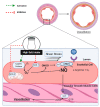Mechanisms of Dietary Sodium-Induced Impairments in Endothelial Function and Potential Countermeasures
- PMID: 33477837
- PMCID: PMC7832854
- DOI: 10.3390/nu13010270
Mechanisms of Dietary Sodium-Induced Impairments in Endothelial Function and Potential Countermeasures
Abstract
Despite decades of efforts to reduce sodium intake, excess dietary sodium remains commonplace, and contributes to increased cardiovascular morbidity and mortality independent of its effects on blood pressure. An increasing amount of research suggests that high-sodium diets lead to reduced nitric oxide-mediated endothelial function, even in the absence of a change in blood pressure. As endothelial dysfunction is an early step in the progression of cardiovascular diseases, the endothelium presents a target for interventions aimed at reducing the impact of excess dietary sodium. In this review, we briefly define endothelial function and present the literature demonstrating that excess dietary sodium results in impaired endothelial function. We then discuss the mechanisms through which sodium impairs the endothelium, including increased reactive oxygen species, decreased intrinsic antioxidant defenses, endothelial cell stiffening, and damage to the endothelial glycocalyx. Finally, we present selected research findings suggesting that aerobic exercise or increased intake of dietary potassium may counteract the deleterious vascular effects of a high-sodium diet.
Keywords: aerobic exercise; dietary sodium; endothelium oxidative stress; glycocalyx; high salt; nitric oxide; potassium.
Conflict of interest statement
The authors declare no conflict of interest.
Figures



References
-
- Dietary Guidelines for Americans 2020–2025. 9th ed. U.S. Department of Agriculture and U.S. Department of Health and Human Services; Washington, DC, USA: 2020. [(accessed on 5 January 2021)]. Available online: Dietaryguidelines.gov.
-
- Elliott P., Stamler J., Nichols R., Dyer A.R., Stamler R., Kesteloot H., Marmot M. Intersalt revisited: Further analyses of 24 hour sodium excretion and blood pressure within and across populations. Intersalt Cooperative Research Group. BMJ. 1996;312:1249–1253. doi: 10.1136/bmj.312.7041.1249. - DOI - PMC - PubMed
Publication types
MeSH terms
Substances
Grants and funding
LinkOut - more resources
Full Text Sources
Other Literature Sources
Medical
Research Materials

